Planeswalker's Guide to Fate Reforged
More than a thousand years before the present day, Tarkir was a rugged place, fraught with perils for dragon and human alike.

Art by Slawomir Maniak
The skies of Tarkir teem with dragons. They spawn from mighty elemental storms, fill the sky with their destructive breath, and terrorize the five warrior clans. There are five dragon broods, named for their biggest and oldest surviving members. Each has a distinct look, disposition, and breath weapon, but all are dangerous foes to the humanoid races of Tarkir.
The Clans of Tarkir
Here, in the past, the five clans of Tarkir still exist. They fight a war against the dragons for their own survival, hoping for some way to gain an advantage in the struggle. They train as dragon slayers, devoting their lives to defending themselves and their families from these predators of the sky.
They're the same clans shown in Khans of Tarkir, but with important differences. The clans of this era, and their khans, focus their efforts toward fighting dragons above all else.
The Abzan Houses
Tarkir's past is even more perilous than its present, as the plane of the past is under the constant threat of dragons. The Abzan understand that they need to work together to survive both the dragons and the harsh environment.

Art by James Ryman
Family bonds are the core of Abzan society, and the clan fights anyone who would threaten these bonds. The Abzan honor the spirits of their ancestors and value their lineage above all else. But they also take in orphans of war from other clans, integrating them into their ranks as "krumar." The greatest fear of a member of Abzan society is to become dishonored and exiled to the sands.
The Abzan have adopted the scale of the dragon as their symbol. Metaphorically, each member of the clan is a single scale, and when combined with the others in their clan, they form an impenetrable defense. In war with the dragons, the scale is also a literal defense. Soldiers claim scales from fallen dragons and incorporate them into their armor for protection.
Daghatar the Adamant, the khan of the Abzan, relies on careful strategy to achieve his goals. He constantly analyzes his surroundings, and this can make him seem aloof. Daghatar rides on a black ibex, and he is clad in elaborate mail crafted from dragon scales. The head of his impressive mace is hewn from amber, in which a malevolent spirit is bound.
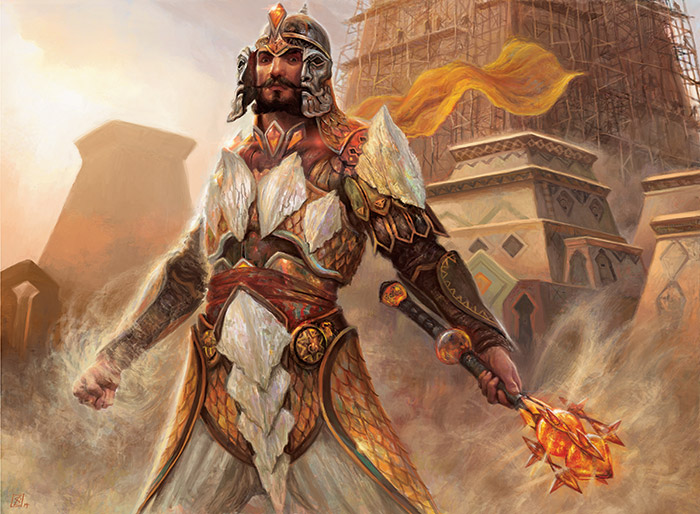
Art by Zack Stella
The Jeskai Way
The Jeskai are martial artists and mystics who seek spiritual enlightenment. Their rigorous training for the body and the mind begins at an early age and continues throughout life. Under the constant threat of dragons, though, this training takes a distinctly defensive turn.

Art by Craig J Spearing
Within isolated strongholds, the Jeskai maintain various mystical styles and schools of thought. Human and efreet monks guide youth, and aven scouts warn of dragon attacks and other threats from above. The impassive djinn form a bulwark both on the ground and in the air.
The Jeskai take the dragon's eye as their symbol, representing both enlightenment and vigilance. They rely on cunning and strategy in combat, using flexible weapons that entangle and immobilize their enemies. A favored tactic is to ensnare dragons with chains and weighted ropes, and then finish them off with hurled spears. The most daring warriors ascend the ropes to engage the dragons in close combat.

Art by Lake Hurwitz
Shu Yun, the Silent Tempest, is the leader of the Jeskai. His relatively youthful appearance belies the fact that he is among the oldest people on Tarkir. Shu Yun is an extremely skilled fighter, having mastered every form of combat known to the Jeskai, and he bears the dragon mark of a ghostfire warrior. He is dedicated to improving the combat skills of every member of the clan.
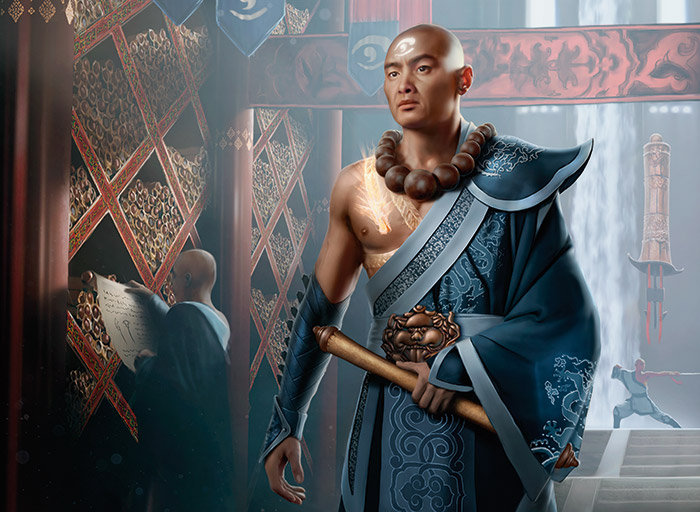
Shu Yun, the Silent Tempest | Art by David Gaillet
Within the catacombs of the Ojutai, Shu Yun and his disciples collect secret knowledge. They seek to preserve this knowledge for Tarkir's future, no matter what fate that future holds.
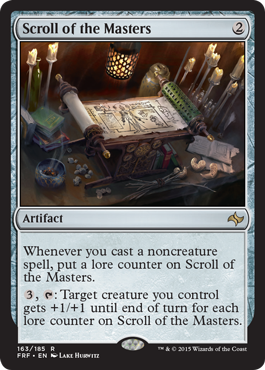
The Sultai Brood
The decadent Sultai rule with cruelty, treachery, and an ever-growing legion of undead servants. The clan's rulers made pacts with demons known as rakshasa to secure their elite status. While naga command respect as dreaded necromancers, they don't dominate the clan.

Art by Volkan Baga
The Sultai use masses of undead to perform menial tasks and as cheap fodder in their armies. They also post unblinking zombie lookouts in treetops and in the towers of their palaces, armed with nets to ensnare dragons that fly too close. The forests surrounding Sultai temples are magically transformed into thorny barriers that shoot envenomed spines at attackers, and soldiers with poisoned crossbows stand always at the ready.
The Sultai's symbol is the fang of the dragon, which represents their readiness to strike and spread their venomous plans. The clan values ruthlessness and spares no thought for the safety of troops, who are easily replaceable zombies themselves—or fuel for new zombies.
Tasigur, the Golden Fang is the young, pampered heir to the Sultai fortune. Pale and slender, he is a hedonist who indulges in cruel pleasures and spares no thought for ruling his realm. He is usually carried about the palace on an ornate platform borne by zombies. Tasigur wears elaborate golden adornments and carries a long, sharp-tipped whip, which he uses on others when he is displeased or simply bored. He especially enjoys tormenting enemies by sending their own undead kin against them.

Art by Chris Rahn
The Mardu Horde
The Mardu are feared warriors who live for battle. They constantly raid other clans with thundering waves of humans, orcs, ogres, and goblins, but they rarely hold the territory they take. They follow a remorseless battle code, and they pillage whatever resources they need from the other clans. Although the Mardu have a mobile lifestyle, they gather in grand encampments between raids.

Art by Viktor Titov
Upon coming of age, a Mardu warrior proves him- or herself in a brutal act of honor, usually killing an enemy in battle, to earn a "war name." The most daring seek renown as dragon slayers. Such hunters leap from a high cliff onto a dragon's back, then hack at its neck or wing pinions to bring it down quickly. Success requires extreme bravery, skill, and luck. Most who attempt this feat die.
The Mardu are symbolized by the wing of the dragon, which represents their swiftness on the attack. Their raiding parties employ fierce battlefield tactics, flawless archery, and vicious war magic to ensure a speedy victory.
Although Alesha, Who Smiles at Death is only nineteen years old, she is the Mardu khan, as well as an expert rider, a fine archer, and a master of the sword. She wields a heavy blade with which she strides fearlessly into hand-to-hand combat. She scoffs at dragonkind, believing them to be nothing more than vermin, and challenges her enemies to face her in battle.
The Temur Frontier
The Temur value strength, savagery, and independence in those in their ranks. They carve out clanholds in the inhospitable Qal Sisma mountain range, and they venture forth frequently from these encampments, spending much of the year hunting game.

Art by Nils Hamm
The Temur live in close accord with the natural order of Tarkir. They live primarily on the bounty of the land, rarely raiding other clans. While their lands are cold and harsh, the Temur are well equipped to weather the wilds. Their seers, known as whisperers, speak to nature spirits and elementals, and communicate among themselves to warn each other of threats and decide upon the best course of action. As a result, the whisperers hold high rank within the clan.
All adult members of the clan—and many of the children—are formidable fighters and experts in wilderness survival. The Temur revere the fury of wild beasts, often riding or fighting alongside sabertooth cats and other large predators in battle. Their clan symbol is the claw of the dragon, which represents these attributes.
Yasova completed a ritual challenge to prove herself worthy of the title of dragonclaw. She is now the khan of the Temur. She is a powerful shaman, adept at calling upon the elemental forces of the mountains and turning her enemies' power against themselves. Yasova is always accompanied by her enormous sabertooth companion.

Art by Winona Nelson
The Dragon Broods of Tarkir
Over the millennia, the spirit dragon Ugin's magic coalesced into powerful storms on his native plane of Tarkir. These magical storms, which became known as dragon tempests, were violent nurseries of powerful magic that birthed dragons. As the storms moved over certain types of terrain, they took on the energy of each environment and produced five unique broods of dragons. Over time, a dominant dragon arose in each brood. These dragons' powers were revered by the clans, and they became the embodiments of the clans' ideals.
Dromoka
To the Abzan, Dromoka is the only dragon worthy of admiration. Dromoka and her brood have breath like a ray of searing light, but their greatest strength is their armored hide: even the heaviest weapons shatter uselessly off their impenetrable scales.
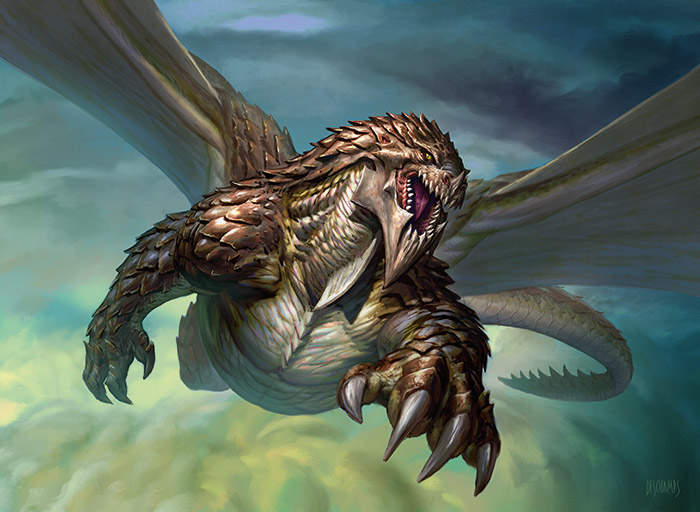
Art by Zack Stella
Dromoka and her brood were drawn to the hot, sunny region where the Abzan settled. Thus, the Abzan must contend with the dragons for control of this territory, even as the Mardu and Sultai encroach. Inhospitable terrain alone cannot defend the Abzan fortress-city of Arashin from aerial attack, so the tightly-knit clan has developed impressive defenses.
Ojutai
To the Jeskai, Ojutai is the dragon that best embodies their ideal of cunning. Gliding silently on feathered wings, Ojutai and his brood freeze prey with their icy breath and pick off the weak. When fighting clans, the dragons confound them with patient tactics, waiting for the clans to make fatal mistakes.
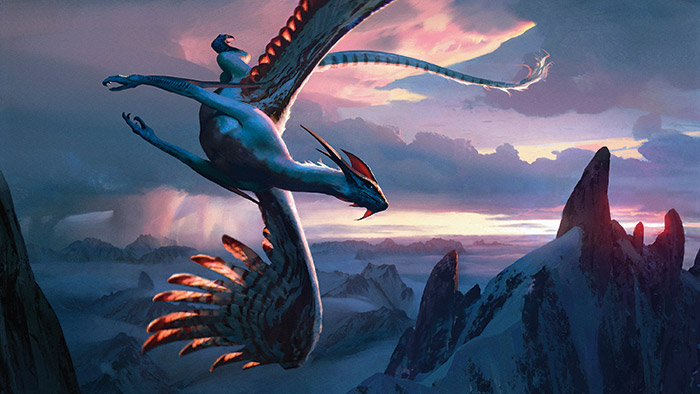
Art by Chase Stone
Ojutai and his brood are cold-loving creatures that lay claim to high peaks, so the Jeskai carve their strongholds into the mountainsides to guard against attack. Specially trained monks maintain enchanted dragon bells and sound a warning when enemies approach.
Silumgar
To the Sultai, dragons represent ruthlessness, and Silumgar stands out above the rest. Silumgar and his brood gloat over the treasure they pillaged from the clans. Any who dare to defy them must face their toxic, corrosive breath.

Art by Steven Belledin
Silumgar and his brood are slimy creatures that are at home in steaming jungles and dank swamps, bringing them into conflict with the Sultai. In response, the clan has developed potent poisons both magical and natural. Zombies are unaffected by toxins, so they are armed with spears and crossbow bolts that drip with venom. Human and naga dragon slayers use stealth to approach within firing range, and then retreat into hiding until the poison from their weapons takes effect.
Kolaghan
The Mardu honor speed above all, and thus Kolaghan is the dragon they revere. Kolaghan and her brood strafe the earth with blazing torrents of lightning, and they are able to hunt down even the swiftest prey. Like the Mardu, they leave nothing behind but ash.
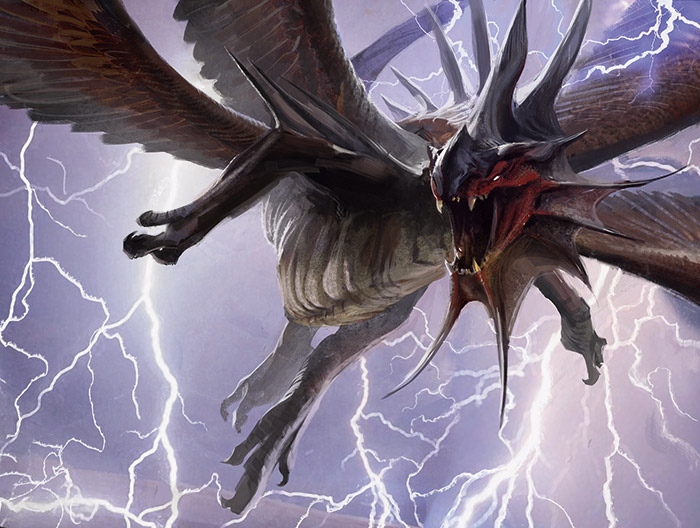
Art by Jaime Jones
Kolaghan and her brood strive to control the rocky hills and steppes of Tarkir. To compete with the dragons, the Mardu deploy increasingly reckless tactics. Many warriors affix upward-pointing sword blades or spears to their shoulders, making them dangerous targets for diving dragons. Sometimes, small groups of fast-moving mounted warriors outfitted with bright streamers ride out to distract dragons, thus protecting the rest of the horde. Such duty is extremely dangerous, but the Mardu compete for the honor of this kind of service.
Atarka
The Temur revere only one dragon: Atarka. Atarka and her brood thunder across the sky, wreaking destruction with their giant plumes of dragonfire. Few can withstand the savagery of their onslaught as they patrol Tarkir to satiate their hunger.

Art by Karl Kopinski
Atarka and her brood prefer to hunt in the snowy mountains where the Temur have built their encampments. Game is scarce, and the dragons' predation has forced the clan to protect its food supply. The Temur establish their outposts in deep caves with icy overhangs, and their shamans weave elemental magic to enhance these shelters with masses of spikes that discourage airborne attack. Temur dragon-fighters prefer to face dragons in solo combat, using their prodigious strength and stubbornness to wrestle and subdue their adversaries.
Planeswalker Profile: Ugin, the Spirit Dragon
Ugin, the Spirit Dragon, is a Planeswalker, and he is ancient beyond measure. His long life has given him a unique perspective on the Multiverse; he sees it as an unbroken whole and seeks to understand its deepest mysteries. He has studied the energetic patterns of entire planes—their creation, destruction, and renewal—and he has applied these universal principles to creating his own form of magic. Ugin's magic deals with the transmutation of matter into energy, and it is a power that can be wielded by all.
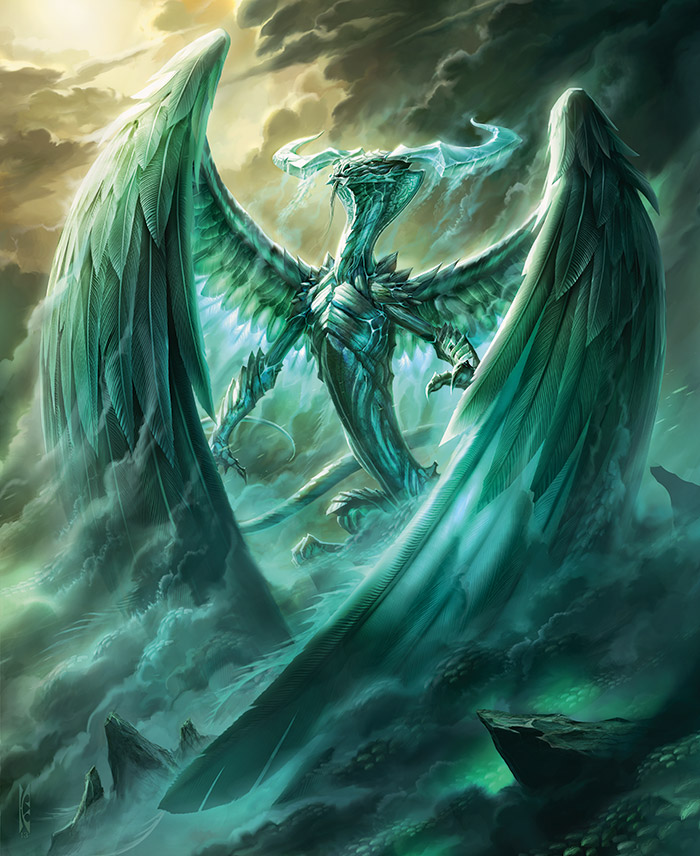
Art by Raymond Swanland
The Eldrazi are another enigma that Ugin has dedicated his life to understanding. He has tracked and documented these great titans in an attempt to comprehend their purpose and nature, and has frowned upon any who have sought to destroy them.
We are all part of a vast tapestry. Break a thread, and that part of the Multiverse unravels. You can never know how small or how large the damage will be until after it is too late. That is why small minds should never be allowed to wield great power.
—Ugin
The Battle of the Elder Dragons
After a rivalry that spanned eons, Nicol Bolas and Ugin—two of the most powerful Planeswalkers the Multiverse has ever known—finally clashed in the sky above Tarkir. When Sarkhan arrived on the scene, he watched in awe as these ancient dragon masterminds unleashed torrents of magic upon each other.

Art by Michael Komarck
What were once cryptic riddles in Sarkhan's mind had become clear. The whispers in his head were not the ravings of an unstable mind; they were a plea from Ugin that had led Sarkhan across time to this place and this moment. Sarkhan knew that the choice he made here would tear the stream of time in two and reforge the fate of an entire plane.
